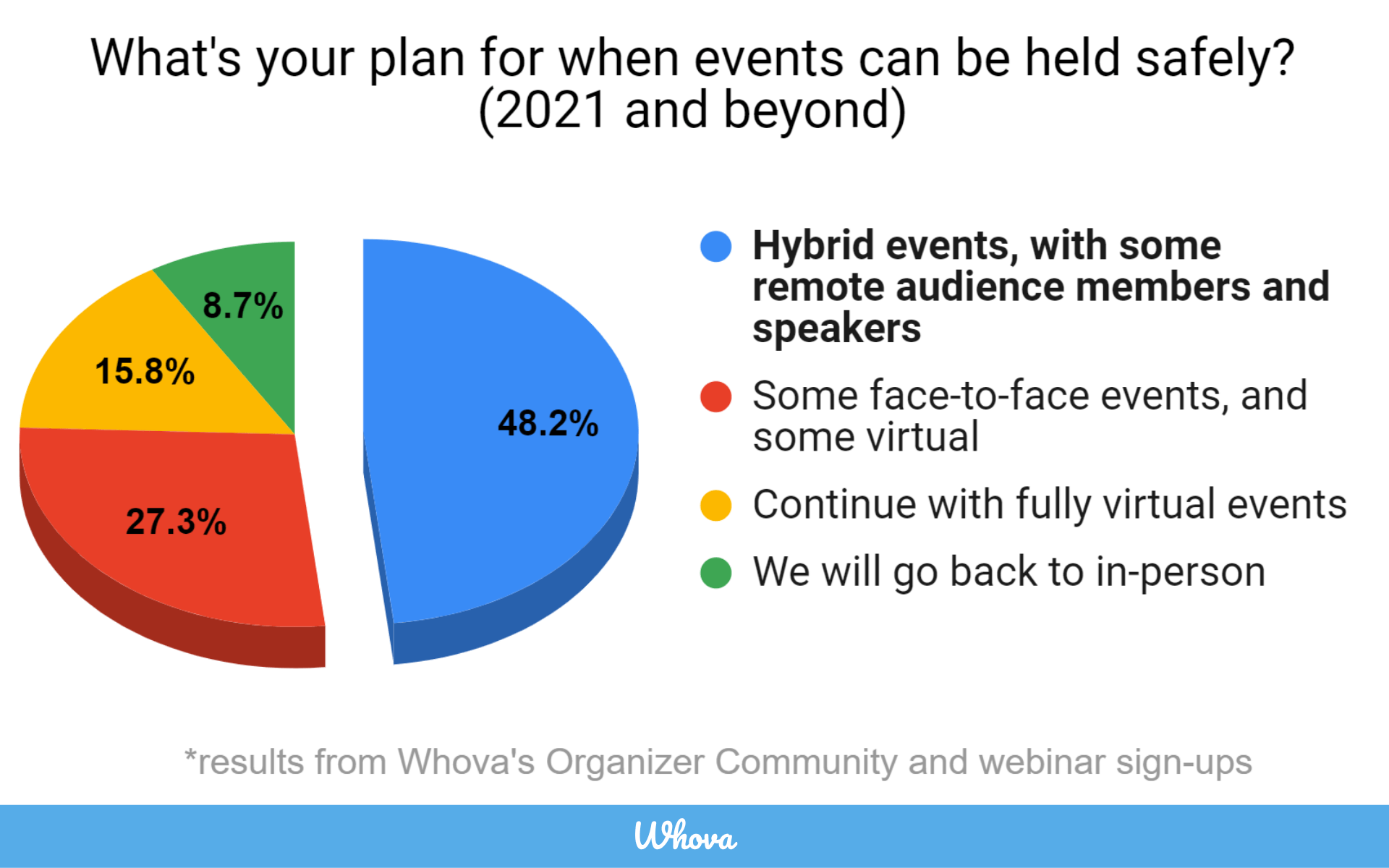
With news of an emerging COVID-19 vaccine, things almost feel like they’re returning to normal. However, this transition will take time, and in the meantime, you’re probably hearing more and more about hybrid events, with many speculating that they’re more than just a temporary fix, and might even become a permanent fixture of the industry. In a recent poll of organizers attending Whova’s webinars, 48.2% said they plan to keep events hybrid after it’s safe to return in-person.

What you might not have heard as much about though, is just how exhausting organizing these events can be. While hybrid events can provide both in-person and virtual benefits, it can be incredibly difficult to cater to both sides at once. We’ve looked into some of the downsides of this format and recommend a strategy you can use to make hosting hybrid events more manageable.
Hybrid events can be seriously exhausting
It’s like running two events at once
Picture yourself running an in-person event: You’re out of bed at 5 AM and onsite soon after to help set up for breakfast and get everything started. As you get everything ready and help resolve any potential issues, you’re already pretty tired before the event even begins, after which you’ll be continuously working to keep things running smoothly.
It’s not too different for a virtual event; while you might be staying at your desk, you’re still working hard to make sure every session starts when it should and that attendees are still getting the same networking and engagement opportunities.
Now picture yourself doing both these things on the same day.

The fact is, hybrid events aren’t as simple as just livestreaming pre-existing sessions. They require careful planning, engagement, and logistical management that differs across both formats.
While bringing people together in-person can be valuable, first consider if a hybrid event outweighs the costs of putting it on.
What works in-person doesn’t always work virtually
In addition to managing the logistics of both events, dealing with virtual and in-person audiences can be very different.
Virtual and in-person attendees have different needs going into events — longer sessions, for instance, are generally more difficult for virtual attendees. As a hybrid organizer, you want to find an approach that works for both groups, so everyone can be fully invested in the experience and not feel like they’re being put second.

Be ready to put in extra work to keep the event safe
Of course, the most important concern is the reason we’re in this situation in the first place: keeping your event safe. While new innovations are helping us return to normal, as an event organizer, you’ll need to be prepared to ensure in-person attendees are testing negative and/or have been vaccinated, and to respond to last-minute changes to travel and safety restrictions. While essential, it’s also a major addition to your already considerable workload.
So, with these facts in mind, what’s the best way to handle moving into a hybrid event space without taking on too heavy of a workload?
We recommend that, instead of trying to run both halves of the event at once, you spread out your content instead.
Make things simpler by dividing the content into two “events”
Hold a limited in-person event and use the filmed contents for the virtual elements
Rather than running both aspects concurrently, give yourself time to balance your workload by hosting a small in-person event and uploading the content once it is over. The recorded video can act as pre-recorded sessions for a larger crowd of virtual attendees. To ensure satisfying engagement, speakers can follow up these sessions with livestreamed Q&A, and organizers can schedule separate virtual networking opportunities so both audiences are catered to.
Provide dedicated networking and engagement opportunities for both audiences
While attendees have similar needs whether they’re at an in-person or virtual event, the best way to address these needs varies by format. Rather than trying to make one format work for both aspects of the event, try providing separate networking and engagement opportunities for virtual and in-person attendees.
Engagement and networking will come easily for your limited in-person event, but be sure to take the time to specifically organize opportunities for your virtual audience, from encouraging speakers to run session polls and take part in virtual Q&A to hosting remote video networking sessions for virtual attendees.
Pick a flexible event tech platform that supports in-person and virtual events
While you may be splitting your event into two, you don’t want to have to learn two completely different event platforms! Simplify event planning with a platform that can easily accommodate both the in-person and virtual elements of your event. Not only will this make things easier for you and your speakers when engaging with both audiences, but it can also bring the two groups of attendees together, allowing them to reach out to each other before the event and letting in-person attendees still participate in virtual networking and engagement opportunities later on.
Whova easily accommodates virtual and in-person events, supporting virtual sessions and engagement opportunities, while helping organize the in-person aspects. You can use the Agenda to give in-person attendees a comprehensive, personalizable schedule, while also including livestreams and pre-recorded sessions in each agenda item for virtual attendees.
Whova also has detailed attendee profiles with video calls and messaging to help attendees network before, during, and after both stages of the event, and makes virtual networking easy with video meet-ups and new features like the Network Tables, a speed-dating-esque online feature that allows participants to expand their networks through video chat with a wide variety of other attendees.
If you’re interested in what else Whova can do for your hybrid event, just reach out today for more information and a free demo.
Related Case Studies
